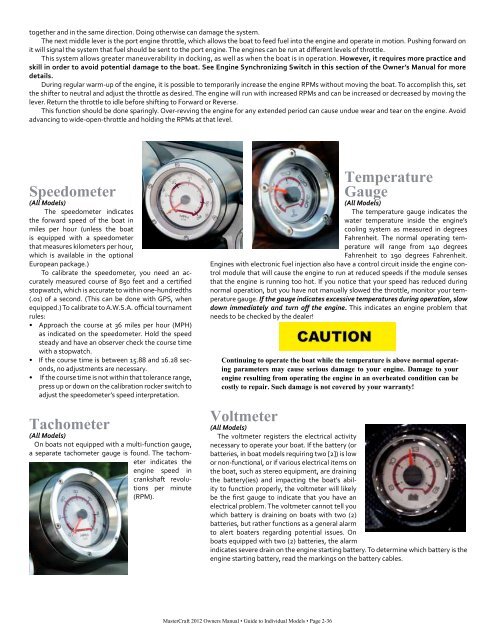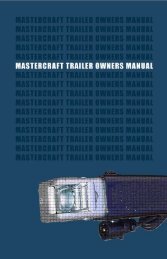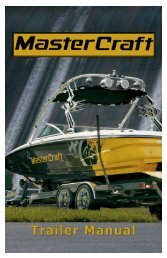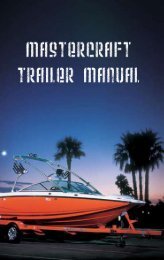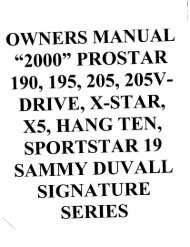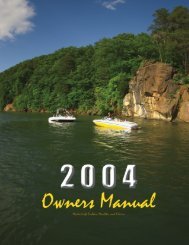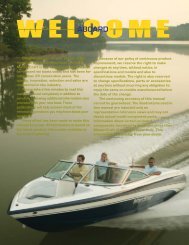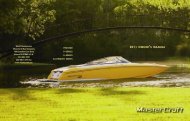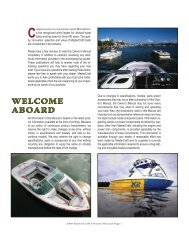2012 MasterCraft Owners Manual
2012 MasterCraft Owners Manual
2012 MasterCraft Owners Manual
You also want an ePaper? Increase the reach of your titles
YUMPU automatically turns print PDFs into web optimized ePapers that Google loves.
together and in the same direction. Doing otherwise can damage the system.<br />
The next middle lever is the port engine throttle, which allows the boat to feed fuel into the engine and operate in motion. Pushing forward on<br />
it will signal the system that fuel should be sent to the port engine. The engines can be run at different levels of throttle.<br />
This system allows greater maneuverability in docking, as well as when the boat is in operation. However, it requires more practice and<br />
skill in order to avoid potential damage to the boat. See Engine Synchronizing Switch in this section of the Owner’s <strong>Manual</strong> for more<br />
details.<br />
During regular warm-up of the engine, it is possible to temporarily increase the engine RPMs without moving the boat. To accomplish this, set<br />
the shifter to neutral and adjust the throttle as desired. The engine will run with increased RPMs and can be increased or decreased by moving the<br />
lever. Return the throttle to idle before shifting to Forward or Reverse.<br />
This function should be done sparingly. Over-revving the engine for any extended period can cause undue wear and tear on the engine. Avoid<br />
advancing to wide-open-throttle and holding the RPMs at that level.<br />
Speedometer<br />
(All Models)<br />
The speedometer indicates<br />
the forward speed of the boat in<br />
miles per hour (unless the boat<br />
is equipped with a speedometer<br />
that measures kilometers per hour,<br />
which is available in the optional<br />
European package.)<br />
To calibrate the speedometer, you need an accurately<br />
measured course of 850 feet and a certified<br />
stopwatch, which is accurate to within one-hundredths<br />
(.01) of a second. (This can be done with GPS, when<br />
equipped.) To calibrate to A.W.S.A. official tournament<br />
rules:<br />
• Approach the course at 36 miles per hour (MPH)<br />
as indicated on the speedometer. Hold the speed<br />
steady and have an observer check the course time<br />
with a stopwatch.<br />
• If the course time is between 15.88 and 16.28 seconds,<br />
no adjustments are necessary.<br />
• If the course time is not within that tolerance range,<br />
press up or down on the calibration rocker switch to<br />
adjust the speedometer’s speed interpretation.<br />
Tachometer<br />
(All Models)<br />
On boats not equipped with a multi-function gauge,<br />
a separate tachometer gauge is found. The tachometer<br />
indicates the<br />
engine speed in<br />
crankshaft revolutions<br />
per minute<br />
(RPM).<br />
Temperature<br />
Gauge<br />
(All Models)<br />
The temperature gauge indicates the<br />
water temperature inside the engine’s<br />
cooling system as measured in degrees<br />
Fahrenheit. The normal operating temperature<br />
will range from 140 degrees<br />
Fahrenheit to 190 degrees Fahrenheit.<br />
Engines with electronic fuel injection also have a control circuit inside the engine control<br />
module that will cause the engine to run at reduced speeds if the module senses<br />
that the engine is running too hot. If you notice that your speed has reduced during<br />
normal operation, but you have not manually slowed the throttle, monitor your temperature<br />
gauge. If the gauge indicates excessive temperatures during operation, slow<br />
down immediately and turn off the engine. This indicates an engine problem that<br />
needs to be checked by the dealer!<br />
Continuing to operate the boat while the temperature is above normal operating<br />
parameters may cause serious damage to your engine. Damage to your<br />
engine resulting from operating the engine in an overheated condition can be<br />
costly to repair. Such damage is not covered by your warranty!<br />
Voltmeter<br />
(All Models)<br />
The voltmeter registers the electrical activity<br />
necessary to operate your boat. If the battery (or<br />
batteries, in boat models requiring two [2]) is low<br />
or non-functional, or if various electrical items on<br />
the boat, such as stereo equipment, are draining<br />
the battery(ies) and impacting the boat’s ability<br />
to function properly, the voltmeter will likely<br />
be the first gauge to indicate that you have an<br />
electrical problem. The voltmeter cannot tell you<br />
which battery is draining on boats with two (2)<br />
batteries, but rather functions as a general alarm<br />
to alert boaters regarding potential issues. On<br />
boats equipped with two (2) batteries, the alarm<br />
indicates severe drain on the engine starting battery. To determine which battery is the<br />
engine starting battery, read the markings on the battery cables.<br />
<strong>MasterCraft</strong> <strong>2012</strong> <strong>Owners</strong> <strong>Manual</strong> • Guide to Individual Models • Page 2-36


